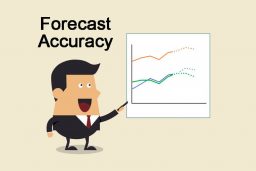
A sales cycle differs depending on the company, service or product: no sales cycle is exactly the same as another. However, the each one does consist of definable phases, which must be tailored using tactics and strategies. Regularly doing so, but especially in the early stages of growth, should be made a high priority as optimizing and shortening the sales cycle has a significant impact on the company’s profitability. The following quick-start guidebook provides help and tips for an optimized sales cycle in the B2B area.
Phases of the Sales Cycle
At the beginning of your business, breaking down the individual phases of your sales cycle is very important. The goal is to clearly define the goal of each respective phase, its necessary activities, and instruct back to the team in an easily absorbable and actionable way. The following graphic illustrates the basic scheme of a sales cycle:
——
The individual phases flow into each other fluently, but the following five points can be emphasized:
1. Awareness Phase
The entry phase refers to the stages of initial contact you have with your potential customers. This phase is primarily driven by marketing and you should highlight the following areas of responsibility:
- Development and definition of the target market
- Preparation and structuring of the prospect list
- Preparation and execution of first contact
- Analytical structure set up as to measure the performance of every campaign or audience variation
- Development and preparation for industry-standard event appearances relevant to your stage of growth
For a successful sales cycle, you should always keep an eye on the buying cycle of your potential clientele and use that as a starting point for developing your marketing strategy. You should have the primary problem that you solve for your customers clearly defined and this must be communicated concisely and consistently across all of your channels. Set up communication frequency and cadence so that you have steady contact over the course of a couple months.
A successful marketing team should have the following qualities:
- Good knowledge of current marketing software
- Excellent writing and grammar skills
- Able to manage several different moving parts simultaneously
- Strong communicator and open to collaboration with teams outside of marketing, such as sales and the web development team
2. Education Phase
The second phase of the sales cycle is the education phase. This is where leads are qualified, direct interest is peaked within qualified leads, and leads are transferred to the sales team to begin their journey through the sales funnel. Overall goals include:
- Qualifying leads to ensure they are relevant
- Educating leads on how your company solves their specific problem
- Additional information about the prospect is gathered to be utilized by the sales team
- Smooth transfer of leads from marketing to the sales team
At this stage, your team needs to be extremely professional and knowledgeable towards their customers. The relationship of trust must be established through aligning with the prospect on a clear articulation of the problem along with a clear but short explanation of how your business solves this problem.
A successful education team should have the following qualities:
- Likes to talk and connect with others
- Sovereign overcoming obstacles such as rejection
- Positive and above all convincing charisma
- Strong Stamina: If contact fails, do not give up contact, but maintain the cycle – and re-seek contact.
3. Selection Phase
This is the decision phase of sales. The customer weighs your solution against what else is in the market and chooses a company to go with. The following tasks arise for sales:
- Identify key decision maker(s)
- Demonstrate value and explain ROI
- Provide official proposal
- Transmission of company references to meet the security needs of the clientele
In this phase, the individual departments of the company must work hand in hand and offer the customer the optimal overall package. For business-critical customers, senior management should be involved in the sales processes.
4. On-boarding Phase
After you’ve won the deal, or in most cases the proof of concept (POC), the on-boarding phase begins. This phase is absolutely essential to the success of your customers and their overall experience of your product or service. During POC scenarios, your ability to on-board plays an equally as critical part as your actual product or service, as you typically cannot have successful use cases without some sort of guidance. In the worst case scenario, you lose your customer in this phase and not only that, but you have likely put a lot of time and resources into them by this point. When your business does lose a customer, try to learn as much as you can as to why. This will help salvage at least some of the resources spent getting the prospect this far.
If you skipped past the POC phase, the on-boarding is still incredibly important as it directly impacts how your customer’s experience – aka, how likely they are to continue using your product or service and how likely they are to recommend you to others.
To prevent the lose of customers during this phase, have a clear on-boarding plan filled-in by the prospects specific needs and situation. Communicate with them regularly to ensure they are absorbing you effectively, correctly, and there is nothing else you can help them with.
It is also important to note that this phase includes truly CLOSING THE DEAL. If you’ve done everything right up to this point you should be in good shape but make sure to assist them in articulating the value you have provided for them since they are likely going to report upward as one last internal check before signing a committing contract. Use pre-determined dates and timelines to ensure the prospects are aware of when they need to have a decision made.
5. Use Phase
After they have officially signed on as one of your customers, true adoption begins. As with the on-boarding phase, this is the continued experience of your customers. As time goes on, renewals quickly take over as a majority of your revenue, which makes this phase arguably the most important. However, this phase heavily dips into the actual use case value of your product or service and thus we will summarizer our coverage of this phase to simply “make sure they are successful and happy”. Make sure you have a killer customer service program set up to maximize this phase.
6. Expansion Phase
The expansion phase is where happy customers are turned into beautiful fountains of revenue. They refer your product to others, which come with the highest chance of closure and thus, should be tracked and flagged as high-priority. As a chain reaction, customers who were referred hold and even greater chance of referring someone else themselves (provided the experience was fantastic), due to their first-hand experience in how you treat referrals. Happy customers also renew their contracts, which as we already stated, are comparatively your easiest deals to close and quickly become a majority. Last but certainly not least, happy customers are much more open to upselling and cross selling. Make sure to put your team in a position where you have enough regular communication with them that you can drop these opportunities in without making your customers feel like an already squeezed fruit.
——
Tips for improving your sales cycle
The continuous development of your sales process is of great importance. Especially in the area of sales, you should consider the following tips for improving your sales cycle by looking at competing companies:
- Take advantage of the analysis phase: Learn from your success stories and non-success stories. Pass on the collected information within your staff and optimize the individual processes.
- Efficiency seeking: Where can time be reduced and what are the bottlenecks in each of your faces. Take careful note of conversion rates between phases and time spent in each phase.
- Clearly defined: Define your individual phases in some sort of tangible form, such as through a flowchart or poster. Make sure your team is aligned on the goals of each phase and that it’s known that these phases are always open to improvement and never poured in concrete. Constantly evolve and recognize past mistakes mistakes.
- Create a schedule: Officially schedule time every month or quarter to deep dive into this process and extensively probe your sales rep’s minds. Get their perspective on what’s working, what’s not, and how they would change it and why. Then combine their zoomed in perspective with your wide lens to make the best possible decisions.
- Talk to your customers: Do not lose contact with existing customers and later new customers. They are goldmines are information and experience and the only true source of expert perspective you have on your sales process OUTSIDE of your own team.
Conclusion
The sales cycle is the heart of your business. For this reason, you must structure and manage this sufficiently. Break down the individual phases that are relevant for your company – so that you can disclose the processes of your business and, if necessary, optimize them. Keep track of the individual sales phases and continue to train your sales staff.
Use the post-processing phase for the analysis of the cycle. Only in this way can you determine customer satisfaction and economically sell your products or services.




